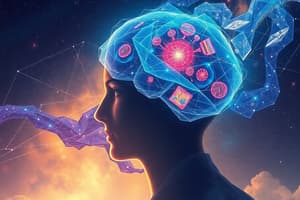Podcast
Questions and Answers
What is decision-making?
What is decision-making?
- A process of randomly selecting an option among several alternatives.
- A process of selecting the option that is most popular.
- A process of selecting a belief or a course of action from several possible alternative options. (correct)
- A process of choosing the option that requires the least effort.
What is the difference between rational and irrational decision-making?
What is the difference between rational and irrational decision-making?
- Rational decision-making is based on random selection, while irrational decision-making is based on emotions.
- Rational decision-making is based on emotions, while irrational decision-making is based on logical reasoning.
- Rational decision-making is based on personal biases, while irrational decision-making is based on logical reasoning and sound judgment.
- Rational decision-making is based on logical reasoning and sound judgment, while irrational decision-making is based on emotions and personal biases. (correct)
What is the state of analysis paralysis?
What is the state of analysis paralysis?
- The state that a person is in when they make decisions based on logical reasoning.
- The state that a person is in when they make careless decisions without detailed planning or thorough systematic processes.
- The state that a person enters where they are unable to make a decision. (correct)
- The state that a person enters when they make a decision based on emotions.
What is the state of extinction by instinct?
What is the state of extinction by instinct?
What is decision fatigue?
What is decision fatigue?
What is the difference between maximizers and satisficers?
What is the difference between maximizers and satisficers?
What are the two kinds of cognitive processes that influence decision-making according to Daniel Kahneman?
What are the two kinds of cognitive processes that influence decision-making according to Daniel Kahneman?
What are the five decision-making styles identified by the General Decision-Making Style (GDMS) test?
What are the five decision-making styles identified by the General Decision-Making Style (GDMS) test?
What is the difference between organizational and individual decision-making?
What is the difference between organizational and individual decision-making?
Flashcards
Decision-making
Decision-making
The act of choosing among multiple options based on values, beliefs, and preferences.
Cognitive process of decision-making
Cognitive process of decision-making
A set of mental processes that involve assessing information, evaluating options, and making a choice.
Analysis paralysis
Analysis paralysis
The state of being unable to make a decision due to overthinking and analysis.
Problem-solving
Problem-solving
Signup and view all the flashcards
Decision fatigue
Decision fatigue
Signup and view all the flashcards
Maximizer
Maximizer
Signup and view all the flashcards
Satisficer
Satisficer
Signup and view all the flashcards
Socioemotional network
Socioemotional network
Signup and view all the flashcards
Cognitive-control system
Cognitive-control system
Signup and view all the flashcards
Study Notes
Cognitive process of decision-making:
-
Decision-making is a cognitive process that involves selecting a belief or a course of action from several possible alternative options.
-
The process can be rational or irrational and is based on assumptions of values, preferences, and beliefs of the decision-maker.
-
Every decision-making process produces a final choice that may or may not prompt action.
-
Decision-making can be regarded as a problem-solving activity that yields a solution deemed to be optimal or at least satisfactory.
-
Human performance has been the subject of active research from several perspectives.
-
The decision-making process involves the analysis of a finite set of alternatives described in terms of evaluative criteria.
-
The decision-maker's environment can play a part in the decision-making process, and environmental complexity is a factor that influences cognitive function.
-
Problem-solving is the process of investigating the given information and finding all possible solutions through invention or discovery.
-
Analysis paralysis is the state that a person enters where they are unable to make a decision, while extinction by instinct is the state that a person is in when they make careless decisions without detailed planning or thorough systematic processes.
-
Decision fatigue is when a sizable amount of decision-making leads to a decline in decision-making skills.
-
Decision-making is a region of intense study in the fields of systems neuroscience and cognitive neuroscience.
-
Decision-making techniques can be separated into two broad categories: group decision-making techniques and individual decision-making techniques.Decision Making: Adolescents, Adults, Cognitive and Personal Biases
-
Adolescents' socioemotional network is activated when exposed to social and emotional stimuli, leading to risk-taking behaviors and addiction-like repetition.
-
Adolescents struggle to control their socioemotional network when psychosocial capacities are present, and their cognitive-control network is still developing.
-
Adults tend to have better control over their risk-taking behavior because their cognitive-control system has matured enough to control the socioemotional network.
-
Biases can affect decision-making processes, especially when there is time pressure, high stress, or high complexity.
-
Cognitive limitations in groups can lead to distorted judgments due to cognitive and motivational biases.
-
There are individual differences between two cognitive styles: maximizers try to make an optimal decision, whereas satisficers simply try to find a solution that is "good enough."
-
Daniel Kahneman theorized that a person's decision-making is the result of an interplay between two kinds of cognitive processes: an automatic intuitive system and an effortful rational system.
-
Aron Katsenelinboigen's analysis on styles and methods of decision-making identified two major styles: positional and combinational.
-
Isabel Briggs Myers claimed that a person's decision-making process depends on their cognitive style, as measured by the Myers–Briggs Type Indicator (MBTI).
-
The General Decision-Making Style (GDMS) test developed by Suzanne Scott and Reginald Bruce identifies five decision-making styles: rational, intuitive, dependent, avoidant, and spontaneous.
-
Organizational decision-making is different from individual decision-making in terms of the number of people involved, the level of information available, and the level of risk involved.
-
Decision-making is affected by cognitive and personal biases, cognitive styles, and the level of information and stress involved.
Studying That Suits You
Use AI to generate personalized quizzes and flashcards to suit your learning preferences.




